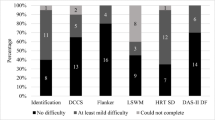Abstract
Seventy-three educationally handicapped (EH) and 78 regular class, normally achieving (NA) boys grades 3–8 were tested with a series of measures selected to test three components of attention: coming to attention, decision making, and maintaining attention over time. EH and NA samples were subdivided into three groups by grade level (grades 3–4, 5–6, and 7–8). Based on a teacher-completed behavioral check list, the EH group was further subdivided according to pupils perceived by teachers as hyperactive or nonhyperactive. With the exception of the youngest group, EH and NA samples did not differ from each other on CA, but regular class boys had slightly higher IQs and better reading scores than did their EH peers;EH hyperactives and EH nonhyperactives differed significantly on reading scores, the difference favoring the nonhyperactives. All pupils were individually administered the Children's Embedded Figures Test (CEFT), the Matching Familiar Figures Test (MFFT), and the Children's Checking Task (CCT), the last designed specifically to assess ability to maintain attention over time. EH pupils did not function as efficiently or as accurately on the attentional tasks as did their normally achieving age peers. Significant differences between EH and NA samples were found for CEFT and MFFT errors, as well as for CCT errors of omission and commission. Analyses of the EH group according to hyperactive-nonhyperactive status were for the most part nonsignificant. Correlational analyses yieMed low but statistically significant relationships among the attentional measures, but nonsignificant relationships between IQ and the attentional test scores. Findings were consistent with the interpretation that the three hypothesized components of attention are partially independent and thus may have differential influence on pupils' performance in school.
Similar content being viewed by others
References
Davies, D. R., & Tune, G. S.Human vigilance performance. New York: American Elsevier, 1969.
Douglas, V. I. Stop, look, and listen: The problem of sustained attentional and impulse control in hyperactive and normal children.Canadian Journal of Behavioral Science, 1972,4, 259–282.
Douglas, V. I. Sustained attention and impulse control: Implication for the handicapped child. InPsychology and the handicapped child, DHEW Publication No. 73-0500, U.S. Department of Health, Education and Welfare, 1974.
Jacobs, N.A comparison of hyperactive and normal boys in terms of reaction time, motor time, and decision-making time, under conditions of increasing task complexity. Unpublished doctoral dissertation, University of California, Los Angeles, 1972.
Kagan, J., Rosman, B. C., Day, D., Albert, J., & Phillips, W. Information processing in the child: Significance of anlytic and reflective attitudes.Psychological Monographs, General and Applied, 1964,78, 578.
Keogh, B. K., & Margolis, J. S. Learn to labor and wait: Attentional problems of children with learning disorders.Journal of Learning Disabilities, 1976,9(5), 276–286.
Keogh, B. K., Tchir, C. A., & Windeguth-Behn, A. Teachers' perceptions of educationally high risk children.Journal of Learning Disabilities, 1974,7(6), 43–50.
Margolis, J. S.Academic correlates of sustained attention. Unpublished doctoral dissertation. University of California, Los Angeles, 1972.
Margolis, J. S., & Keogh, B. K.School achievement and ability to maintain attention to task: A vigilance model applied to school learning. Paper presented at the Annual Meeting of the Western Psychological Association, San Francisco, California, April 1974.
McGrath, J. J. Some problems of definition and criteria in the study of vigilance performance. In D. N. Buckner & J. J. McGrath (Eds.),Vigilance: A symposium, New York: McGraw-Hill, 1963.
Schain, R. J.Neurology of childhood learning disorders. Baltimore: Williams & Wilkins, 1972.
Winer, B. J.Statistical principles in experimental design (2nd ed.). New York: McGraw-Hill Book Co., 1971.
Witkin, H. A., Oltman, P., Raskin, E., & Karp, S.Manual for the children's embedded figures test. Palo Alto: Consulting Psychologists Press, 1971.
Author information
Authors and Affiliations
Additional information
This research was supported in part by U.S. Public Health Service Grant No. 1 RO 1 25076-01A1 and Contract No. 5893, between the State Department of Education and the University of California, Los Angeles.
Rights and permissions
About this article
Cite this article
Keogh, B.K., Margolis, J.S. A component analysis of attentional problems of educationally handicapped boys. J Abnorm Child Psychol 4, 349–359 (1976). https://doi.org/10.1007/BF00922532
Issue Date:
DOI: https://doi.org/10.1007/BF00922532




